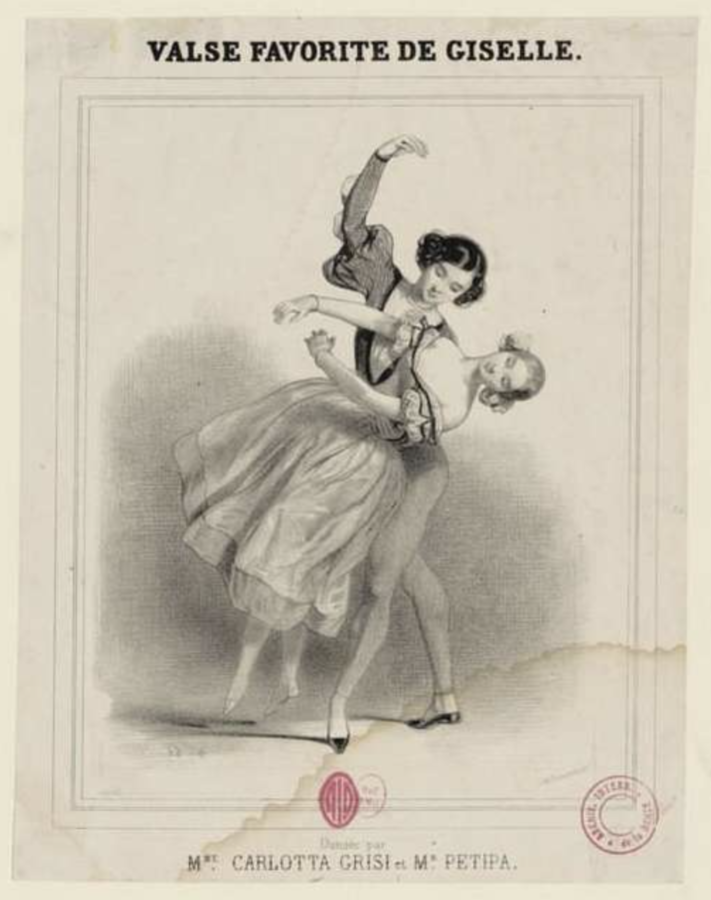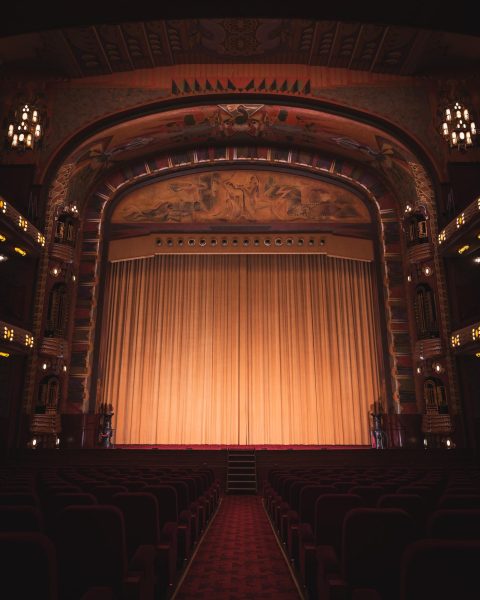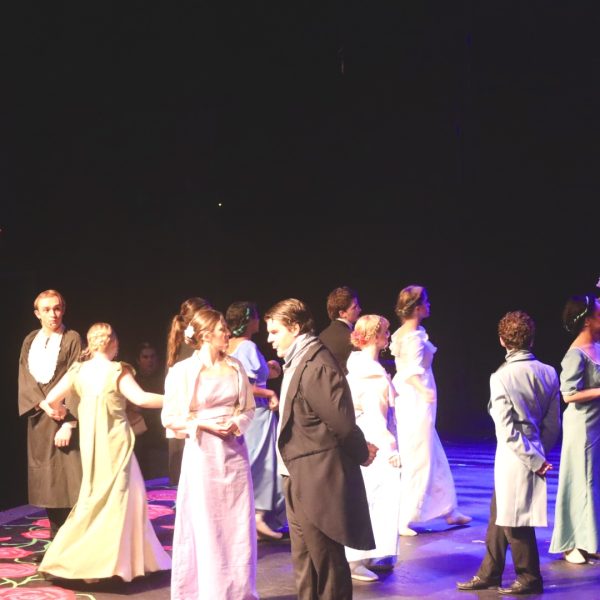Giselle and The United Ukrainian Ballet
Giselle print from the original 1841 production, two people are shown dancing together. Originally created in 1841, this Giselle print features Caroletta Grisi and Petipa, the original lead dancers for the ballet.
According to the Smith Center, on June 28, 1841, Giselle premiered at the Paris Opera ballet, and from Feb. 1 to Feb. 5, Giselle was at the Kennedy Center, performed by The United Ukrainian Ballet. Giselle is a classic ballet that was created in the romantic era by Theophile Gautier, after he was inspired by Carlotta Grisi and two ghost stories in 1841, according to The National Ballet of Canada. Yet, Giselle is still being played today by ballet companies all over the world in the 21st century and for the first week of February, Giselle was preformed by The United Ukrainian Ballet. To people outside of the ballet community, Giselle isn’t well heard of as Swan Lake or The Nutcracker, but with The United Ukrainian Ballet’s production in the Kennedy Center, Giselle may become a household name. Ballet may once again be an art form with widespread appreciation and support.
The History of Giselle
Giselle was written by French author Théophile Gautier in 1841, who, according to the Pacific Northwest Ballet, was a “colorful balletomane, poet, critic, man-about-town, and staunch defender of Romanticism.” He was deeply influenced by “Phantoms” by Victor Hugo and “On Germany” by Heinrich Heines. “Phantoms” is a poem about a girl who died due to her love of dance. “On Germany” is about the wili, a slavic myth about female spirits who punish men by dancing with them until they die of exhaustion. The ballet features its two protagonists, Giselle, a peasant, and the nobleman-disguised-as-a-peasant Albert, sometimes called Alberchet. The influence of these two poems can be seen in the story of Giselle; in the ballet, the peasant Giselle loved to dance. However, because Albert, her lover, cheated on his fiance for Giselle and lied to her about his class, Giselle became a wilis. Due to Albert’s actions, Giselle was heartbroken and killed herself. Because Gautier lacked experience in writing ballets, he worked with Vernoy de Saint Georges after meeting him backstage at the Opéra, and soon enough, the ballet came into fruition with rehearsals, crew and music prepared by Adolphe Adam. Giselle finished production in two months as the Opéra’s director Léon Pillet urgently pushed the project in order to capitalize on the popularity of Carlotta Grisi, a popular ballerina at the time. Jean Coralli and Jules Perrot also worked on choreographing the ballet in its original production, though it has been adjusted throughout the years by many other choreographers. Giselle also preached themes of romanticism, as it took place in the countryside, with Giselle being a peasant in a sunny village and becoming a supernatural creature at the end.
The United Ukrainian Ballet
The United Ukrainian Ballet Foundation, which funds The United Ukrainian Ballet Company, is a foundation created by Ukrainians to “protect, support and spread the Ukrainian culture that has come under great pressure since the war.” The company, founded in 2022 following the Russian invasion of Ukraine, operates at the Dutch Centre for Ukrainian Dancers in The Hague. The foundation claims that they wish to provide support to refugee Ukrainian dancers as soon as possible so that they can “immediately continue their cultural activities in their own country.” The foundation is a non-profit organization and in the long term, plans to raise funds to support Ukraine in reconstruction after the war. The company also consists of 50 refugee Ukrainian dancers and crewmembers, including former Dutch National Ballet prima ballerina Igone de Jongh, who is also the artistic director for the company. Going back to Giselle, the ticket sales from Giselle will also go to the Disasters Emergency Committee, an organization made up of 15 United Kingdom aid charities and The United Ukrainian Ballet Foundation itself. The ballet has also been reinterpreted and choreographed by the renowned Alexi Ratmansky, a former choreographer for the American Ballet Theater and an artistic director for the Bolshoi Ballet. It’s also important to note that earlier and still to this day, men aren’t allowed to leave Ukraine without special permission; but when the Ukrainian government realized the significance of preserving Ukrainian culture, it allowed male dancers to leave.
Giselle at the Kennedy Center
From Feb. 1-5, Giselle was performed by the The United Ukrainian Ballet Company with a rotating cast at the Kennedy Center. It ended at around 10:00pm and overall, it was admirable, especially considering the fact that a lot of these dancers may have trauma from leaving their homeland. With the exception of the dancers singing the Ukrainian anthem at the end of the performance, Giselle wasn’t changed much to fit within the interpretation of Ukrainian struggles. Despite that, the core message displayed in the performance reflected Ukrainian struggles and a message of hope, as in the playbill, Ratmansky is quoted saying; “Well, that’s her [Giselle’s] struggle. It’s a beautiful conflict. She’s very much a loving soul, but she’s a wili, and she’s under the power of Myrtha [wili queen], who orders her to dance Albert to his death. But love prevails. I hope I have been able to show that even more in this production: love prevails.” However, a couple of changes stand out in the ballet, as Ratmansky sought to keep to the original choreography and story, allowing a couple of additions made in the 19th century by choreographers Aruthur Saint-Leon and Marius Petipa, to stay in his interpretation. One of those changes is that in the original 1841 production, Albert’s fiance, Bathilde, is sympathetic towards Giselle’s situation; rather than being cruel to Giselle as often depicted in modern performances of the ballet, she becomes a friend of hers and consoles Albert for his loss. At the end, Giselle tells Albert to marry her as she slowly disappears into the day. In modern productions, at the end of Giselle, Giselle reluctantly falls back asleep to her grave while Abert cries. In this production, Ratmansky decided to go with the original ending. Another change is that in this production of Giselle, Giselle doesn’t kill herself but instead dies of heartbreak. While she does attempt to kill herself with Albert’s royal sword, a guy named Hilarion, who was also fond of Giselle, stops her from doing so. Modern day productions normally have Giselle successfully stab herself, but both versions have her finally die after she dances and falls into Albert’s arms.
However, despite Giselle being performed all over the world, ballet itself is also a source of nationalism to Russia, as Alexi Ratmansky said in an interview by the CBC “This [Bolshoi ballet] is something that celebrates Russia. Every important guest who would visit Soviet Union would be invited to the Bolshoi, see the performance. And that was a pride of, of Russia at any time.” Ratmansky left the Bolshoi ballet company after Russia invaded Ukraine because of the strong political ties that the Bolshoi theater had with the Russian government. So did many other dancers, according to CBS, like former Bolshoi prima ballerina Olga Smirnova, who left Russia to join the Dutch National Ballet. While the art of ballet dates back to Italy and is a source of nationalism to Russia, ballet is still very important to Ukrainians as it’s a core part of Ukrainian culture. Ballet is an old art form that has persisted since the 1500s, according to the Alanta Ballet, and hopefully will continue to do so in the future.











